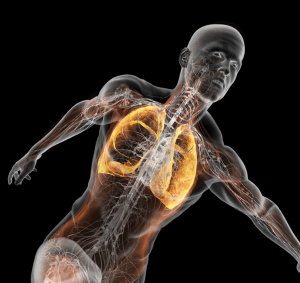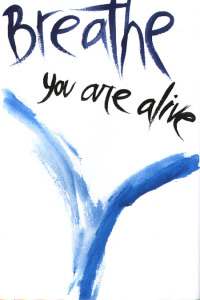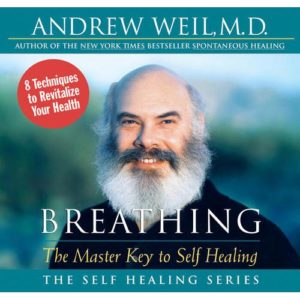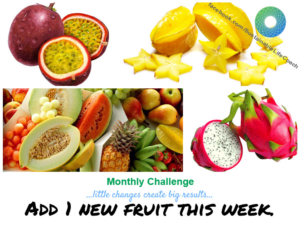How often are you conscious of your breathing? Is it when you are exercising and gasping for that precious air or when you are watching a scary movie and suddenly feel light headed because you’ve stopped breathing? Breathing, for most people, is left to the automatic pilot that runs things while we’re distracted elsewhere. But I want you to consciously be aware of your breathing. Breath work is a powerful tool to increase energy, aid in detoxification and wind you down when things get a little crazy.
Give Me Oxygen Or Give Me…
Life starts and stops with a breath. We survive without food for weeks, without water for days, but without air we cannot survive more than a few minutes. This says a lot of how important our breathing is. Breathing is important for two reasons. It is the only means to supply our bodies and its various organs with the supply of oxygen which is vital for our survival. The second function of breathing is that it is one way we get rid of waste products and toxins from the body. Our breathing is usually too shallow and too quick. We are not taking in enough oxygen and we are not eliminating enough carbon dioxide. As a result, our bodies are oxygen starved, and a toxic build-up occurs. Every cell in the body requires oxygen and our level of vitality is just a product of the health of all the cells.
LET’S GET TECHNICAL: 10 Benefits of Increased Oxygenation
- Improved Blood Quality – This helps eliminate toxins from the system.
- Better Digestion – The digestive system receives more oxygen and flows more efficiently.
- Healthier Nervous System – This improves the health of the whole body, since the nervous system communicates to all parts of the body.
- Rejuvenation of the Glands – Especially the pituitary and pineal glands. The

lungs brain loves oxygen! It requires three times more oxygen than the rest of the body. This has far-reaching effects on our well being.
- Rejuvenation of the Skin – The skin becomes smoother and a reduction of facial wrinkles occurs.
- Lung Power Increases – A good insurance against respiratory problems.
- Reduces Work Load for Heart – The result is a more efficient, stronger heart that operates better and lasts longer. It also means reduced blood pressure and less heart disease.
- Weight Control – If you are overweight, the extra oxygen burns up the excess fat more efficiently. If you are underweight, the extra oxygen feeds the starving tissues and glands.
- Increased Energy – It is the mitochondria of the cells that produce almost all our energy (called ATP) through combustion of nutrients and oxygen, and the mitochondria cannot function without oxygen. Deeper breathing fuels ATP to run efficiently providing more energy for us.
- Relaxation of the Mind and Body – Slow, deep, rhythmic breathing causes a reflex stimulation of the parasympathetic nervous system, which results in a reduction in the heart rate and relaxation of the muscles. These two factors cause a reflex relaxation of the mind, since the mind and body are very interdependent. In addition, oxygenation of the brain tends to normalize brain function, reducing excessive anxiety levels. Love this benefit!
 Ok, so now we have a scientific understanding of the importance of deep oxygen rich breathing to our fabulous bodies. We all agree this is something we’ll benefit from and are ready to throw bad breathing habits to the curb, right? Great! Poor breathing habits are very common. But most people don’t realize that their own breathing is not as good as it could be. Take a look at the list below. You may be surprised to see that any of these activities is a sign that your breathing habit is poor:
Ok, so now we have a scientific understanding of the importance of deep oxygen rich breathing to our fabulous bodies. We all agree this is something we’ll benefit from and are ready to throw bad breathing habits to the curb, right? Great! Poor breathing habits are very common. But most people don’t realize that their own breathing is not as good as it could be. Take a look at the list below. You may be surprised to see that any of these activities is a sign that your breathing habit is poor:
– clearing your throat when you are stressed (throat-clearing is a form of breathing)
– holding your breath while you concentrate
– breathing forcefully when you talk
– keep your mouth open while you exercise
– snoring when you sleep (snoring is a form of breathing)
BREAKING BAD HABITS
- Sit up! Don’t slouch when you are at your desk. There were some interesting studies done that showed the more someone focused on a task the more slouched they became and the less oxygen they took into their system. Be aware and sit up tall to give your lungs the room to breathe deeply.
- Breathe through your nose. Don’t be a mouth breather! A good, conscious breathing pattern means that our breathing is in and out through the nose, deep (not big), reaching down into our stomach, and is slow and relaxed, rhythmic and quiet. That’s all there is to it, simple right?!
EXERCISE THOSE LUNGS
I love Dr. Weil’s breathing exercises. They really help build powerful lungs and calm me when things get a little tense in my life. They work wonders and, if truth be told, help keep me off blood pressure meds!
Exercise 1:
The Stimulating Breath (also called the Bellows Breath)
The Stimulating Breath is adapted from a yogic breathing technique. Its aim is to raise vital energy and increase alertness.
- Inhale and exhale rapidly through your nose, keeping your mouth closed but relaxed. Your breaths in and out should be equal in duration, but as short as possible. This is a noisy breathing exercise.
- Try for three in-and-out breath cycles per second. This produces a quick movement of the diaphragm, suggesting a bellows. Breathe normally after each cycle.
- Do not do for more than 15 seconds on your first try. Each time you practice the Stimulating Breath, you can increase your time by five seconds or so, until you reach a full minute.
If done properly, you may feel invigorated, comparable to the heightened awareness you feel after a good workout. You should feel the effort at the back of the neck, the diaphragm, the chest and the abdomen. Try this breathing exercise the next time you need an energy boost and feel yourself reaching for a cup of coffee.
Watch a video of Dr. Weil demonstrating the Stimulating Breath.
Exercise 2:
The 4-7-8 (or Relaxing Breath) Exercise
This exercise is utterly simple, takes almost no time, requires no equipment and can be done anywhere. Although you can do the exercise in any position, sit with your back straight while learning the exercise. Place the tip of your tongue against the ridge of tissue just behind your upper front teeth, and keep it there through the entire exercise. You will be exhaling through your mouth around your tongue; try pursing your lips slightly if this seems awkward.
- Exhale completely through your mouth, making a whoosh sound.
- Close your mouth and inhale quietly through your nose to a mental count of four.
- Hold your breath for a count of seven.
- Exhale completely through your mouth, making a whoosh sound to a count of eight.
- This is one breath. Now inhale again and repeat the cycle three more times for a total of four breaths.
Note that you always inhale quietly through your nose and exhale audibly through your mouth. The tip of your tongue stays in position the whole time. Exhalation takes twice as long as inhalation. The absolute time you spend on each phase is not important; the ratio of 4:7:8 is important. If you have trouble holding your breath, speed the exercise up but keep to the ratio of 4:7:8 for the three phases. With practice you can slow it all down and get used to inhaling and exhaling more and more deeply.
This exercise is a natural tranquilizer for the nervous system. Unlike tranquilizing drugs, which are often effective when you first take them but then lose their power over time, this exercise is subtle when you first try it but gains in power with repetition and practice. Do it at least twice a day. You cannot do it too frequently. Do not do more than four breaths at one time for the first month of practice. Later, if you wish, you can extend it to eight breaths. If you feel a little lightheaded when you first breathe this way, do not be concerned; it will pass.
Once you develop this technique by practicing it every day, it will be a very useful tool that you will always have with you. Use it whenever anything upsetting happens – before you react. Use it whenever you are aware of internal tension. Use it to help you fall asleep. This exercise cannot be recommended too highly. Everyone can benefit from it.
Watch a video of Dr. Weil demonstrating the 4-7-8 Breath.
Exercise 3:
Breath Counting
If you want to get a feel for this challenging work, try your hand at breath counting, a deceptively simple technique much used in Zen practice.
Sit in a comfortable position with the spine straight and head inclined slightly forward. Gently close your eyes and take a few deep breaths. Then let the breath come naturally without trying to influence it. Ideally it will be quiet and slow, but depth and rhythm may vary.
- To begin the exercise, count “one” to yourself as you exhale.
- The next time you exhale, count “two,” and so on up to “five.”
- Then begin a new cycle, counting “one” on the next exhalation.
Never count higher than “five,” and count only when you exhale. You will know your attention has wandered when you find yourself up to “eight,” “12,” even “19.”
Try to do 10 minutes of this form of meditation.
Watch a video of Dr. Weil demonstrating Breath Counting.
You can find more here: Dr. Weil’s Breathing Tools
YOUR CHALLENGE
Since we always breathe, we have the potential to practice breath awareness at any and every waking moment. Challenge yourself to be more aware of your breathing throughout you day. Is it shallow? Can you create the habit of breathing from the belly instead of the chest? Sure you can! Work through the exercises above and FEEL the difference – it is FANTABULOUS!



